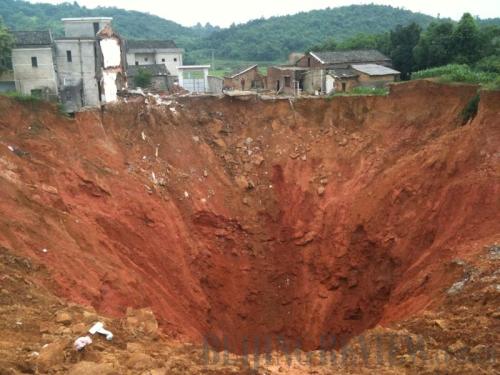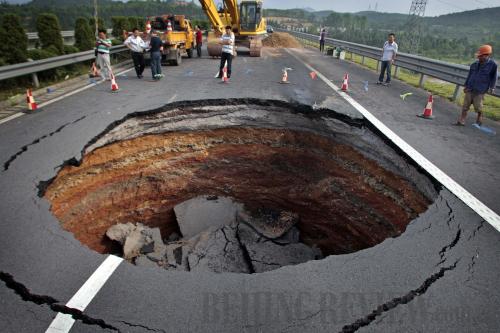|
 |
 |
|
EARTH SINKING: The scene of the sinkhole in Qingquan Village of Ningxiang County in Hunan Province on June 10 (CFP) |
WHAT A HOLE! On June 4, the surface of a highway in Quzhou City, Zhejiang Province, suddenly sinks and there appears a sinkhole (CFP) |
Around 8 p.m. on June 8, a villager's toilet suddenly became a 5-meter-wide sinkhole in Qingquan Village of Ningxiang County in central China's Hunan Province.
The villager, according to the Xiaoxiang Morning Herald, said he could even hear the sound of flowing water in the sinkhole.
The same night, a large area of a farmland outside of the village sank into a water pit.
Local authorities said a large number of sinkholes in the county have appeared since May. Some have been as deep as 15 meters, damaging buildings, bridges, electricity poles and cutting power supplies to villages.
The most serious one happened at Fuquan Primary School in Dachengqiao Town, Ningxiang County, leaving a hole with a diameter of 80 meters, said Li Jun, a local official.
In fact, the sinkholes in Ningxiang are among many such cases in China since late April.
In Changning County in southwest China's Sichuan Province, 26 pits formed within one week beginning on April 27, Sichuan News Network reported on May 3.
The largest one is 60 meters in diameter and 40 meters deep. About 290 nearby residents have been evacuated from the area, according to local authorities.
Similar incidents have been reported in Sichuan's Chengdu and Chongzhou cities. Other provinces such as Zhejiang, Jiangxi, Guangdong and Gansu, as well as Chongqing Municipality and Guangxi Zhuang Autonomous Region, have also reported sinkholes.
On April 23, a ground subsidence formed a pit of more than 400 square meters in Meizhou in south China's Guangdong Province.
On the morning of June 4, the surface of a highway in east China's Zhejiang Province suddenly sank, leaving a sinkhole 8.3 meters wide and 6 meters deep.
From May 31 to June 2, Guangxi suffered heavy rainstorms when it entered the flood season. Over three days, torrential rain and subsequent floods and landslides hit 42 counties in nine cities, including Laibin, Yulin and Wuzhou, according to the regional flood control and drought relief office.
Since June 3, four enlarged sinkholes formed around Jili Village of Laibin City. Three are 70 meters in diameter and one is 300 meters, the office said.
Experts said that the cave-in area had been getting bigger and the depression had also grown from 20 meters to 25 meters in depth.
A special team of geologists has been formed to study the phenomenon, the office said.
"Judging from this part, there is no doubt that it is a limestone cave-in, and it has something to do with the rainstorms. There had been a drought, and the rain has caused sudden increase in water levels. All of these factors have affected the pressure level in the limestone cave," Geologist Shi Jie said.
Wang Yongjun, a geological engineer with Yibin Municipal Bureau of Land and Resources of Sichuan, said that karst topography was the main cause of most of the sinkholes because the peculiar geological structure is easily dissolved by rain, groundwater and even wind.
"Of course, the sudden increased rainfalls after a long-time drought beginning last autumn and the over-pumping of groundwater may also cause land subsidence and sink-holes," Wang said. n
Major Sinkholes
On April 23, a ground subsidence formed a pit of more than 400 square meters in Meizhou, Guangdong Province.
Since April 27, 26 pits have formed within a week in Changning County of Sichuan Province.
On May 31, a sinkhole 2 meters wide and 2 meters deep appeared in a highway in Tongliang County in Chongqing Municipality.
On June 3, due to the rain-triggered landslides in Jili Village of Laibin in Guangxi, a field of about 3.3 hectares sank.
On June 4, the surface of a highway in Quzhou City, Zhejiang Province, suddenly sank and there appeared a sinkhole with 8.3 meters wide and 6 meters deep.
On June 8, a 5-meter-wide sinkhole suddenly appeared in a villager's toilet in Qingquan Village of Ningxiang County in Hunan Province.
(Source: CCTV)
| 